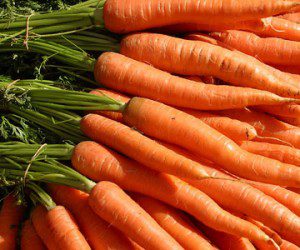Contributing Writer for Wake Up World
Our household loves carrots. Nimue will walk around like Bugs Bunny all day long. I remember when she was younger and her sweet face was stained orange constantly from them! Arianne likes them in sticks and Caoilinn likes them as circles so she can poke the middle out of them. Rhiannon and Gwendolyn will reach for a chopped handful as they run out the house. And of course we love them in our green smoothies.
We eat carrots plain, splashed with balsamic vinegar, dipped in a garlicky cashew sunflower spread or lightly sauteed in lemon and garlic and more. I don’t have to tell my kids about all the benefits of eating these vegetables, they just seem to innately know. I do still talk about those benefits though. I can’t seem to help it as it is a bit of an obsession with me.
Carrots are an alkaline food which is great as todays conventional diet is extremely acidic. They are high in fiber and a good source of vitamin C and of course the well known beta carotene component. We were all brought up with the knowledge that carrots are high in vitamin A and excellent for eye health. But did you know that they also make excellent facials and hair masques?
Carrot Facial Recipe
2 to 3 large organic carrots
2 tbsp. raw honey
1 tbsp. organic coconut or olive oil
2 tbsp. water (or as needed)
Boil chopped carrots until soft and tender and then mash until creamy.
Add the honey and olive oil to the carrots and mix until all ingredients are completely blended.
If the mixture appears too thick add the water as needed until it is a smooth, creamy consistency.
Cleanse and rinse your face with warm water before applying the mask to open your pores.
Apply the mask to your face and allow it to set for apx 20 minutes.
Rinse your face gently with warm water and dry.
This is a great masque for those with mature or oil skin types.
Touted as an anti cancer food due to their high amounts of phytonutrient antioxidants carrots have been in the news over the last few years due in part to a study from the Netherlands that shows how upping your carrot intake lowers your risk of cardiovascular disease.
According to What’s on My Food there are 26 pesticide residues found in carrots. Many of these have known health effects that include hormone disruptors, neurotoxins, carcinogens, developmental or reproductive toxins. Bee toxicity is a huge issue as well.
Take for instance Trifluralin which is used as a pre-emergent herbicide. Traces were found in commercially grown carrots apx 50% of the time. It is listed as a suspected hormone disruptor and possible carcinogen. When used on its own many farmers may believe that it is safer than some of the other herbicides and therefore the lesser evil. Unfortunately these chemicals are not just used exclusively. More often they are paired with other chemicals for broader spectrum use.
For example, Simazine, metribuzin, and pendimethalin will “control” certain weeds and grasses that are resistant or are developing resistance to Trifluralin. When coupled with other chemicals there may be multi toxic effects and chemical reactions that the scientific world has never fully studied.
Some herbicides will degrade in sunlight and so have to be incorporated into the soil as opposed to directly applying to the plant. Also, depending on the maker of these products the solvents used to create them can prove toxic. An example of this is when a recent batch of Trifluralin was withdrawn from market due to the fact that people were becoming nauseous when exposed to it.
Carrots are a food crop that many commercial growers will use Trifluralin on. So my solution is to grow your own or buy organic.
Adding things to the soil is a concern for me especially when you consider the fact that just 1 teaspoon of rich organic soil can hold up to one billion bacteria, several yards of fungal filaments, several thousand protozoa and scores of nematodes. It is alarming to think how they are affected by the above mentioned chemicals. Not to mention the gentle giants of the soil world, worms and millipedes.
Soil is more than just a blank slate medium to grow food that has to be fed with artificial fertilizers. True, these fertilizers supply specific nutrients but they can not replace all the other kinds of food that bacteria and fungi needed to keep the soil viable. More organic matter, more life in our food. More life in the soil more disease and pest protection for our food crops. The use of herbicides or pesticides on the soil will only degrade, kill off or mutate beneficial micro organisms. Everything is affected by our actions from the plants and bugs we are trying to avoid to the ones we are trying to grow. Organic techniques used by an individual or the farmers we depend on to feed us is critical in maintaining the health of our soil. If our soil is healthy we have a better chance of being healthy as well. And who doesn’t want that?
Carrot Cake In-The-Raw
This is my favourite cake. I use only fruit as a sweetener, and it is oh so rich.
2 cups finely ground organic carrots
1 cup organic raisins or sultanas, soaked in water about 1 hour (save soak water)
1 cup organic dates
1 cup organic walnuts or pecans
1 ½ tsps cinnamon
1 ½ tsps nutmeg
1 organic lemon zest
1 organic orange zest
¼ cup dried organic pineapple, diced small
2 tsps organic vanilla
¼ tsp himalayan or celtic sea salt
Frosting:
2 cups organic raw cashews
½ cup of raisin or sultana soak water from above, adding more if necessary
2 Tbs organic lemon juice
Several drops of liquid stevia to taste or other organic sweetener of choice
2 tsps organic vanilla
zest of 1 organic lemon
Press excess liquid from carrots, if necessary. Process sultanas, dates and nuts in food processor or strong blender until finely ground. Combine well with remaining cake ingredients.
Prepare frosting. Process all ingredients in blender until smooth. Add more soak water, if necessary, to achieve desired consistency.
Line a 10 inch pie pan with baking paper. Press half of cake mixture into pan. Turn pan over onto serving plate. Remove pan.
Spread half of frosting over top. Repeat, moulding with remaining mixture. Gently release on top of first layer. Spread remaining frosting on top and sides of cake.
Garnish with cinnamon and chopped nuts, if desired, and serve.
Article Sources
whfoods.com/genpage.php?tname=foodspice
whatsonmyfood.org/food.jsp?food=CR
apvma.gov.au/news_media/media_releases
Previous Articles by Jeani-Rose
- How To Counter Radiation With Your Food!
- Superfood Recipe – Quinoa (keen-wah)
- A Peruvian Gift and A Toxic Poison
- Recipe: Cashew-Sunflower “Mayonnaise” or Dip
- Recipe: Dreamy Organic Chocolate Avocado Pudding
About the Author
Jeani-Rose Atchison is a health advocate, and home-schooling mother of five who also finds time to write about nutrition, whole foods and environmental concerns. She authored, Every Day Vegan – 300 recipes for healthful eating which is a mainstay in vegetarian kitchens. Atchison’s latest book, Food for Thought – Thought for Food is chock full of delicious whole food recipes. It also takes a controversial look at the food we eat today and the processes involved in bringing it to your table. Can your food make you ill? The answer may shock you!
To find out more go to Jeani-Rose’s Facebook or Website

If you've ever found value in our articles, we'd greatly appreciate your support by purchasing Mindful Meditation Techniques for Kids - A Practical Guide for Adults to Empower Kids with the Gift of Inner Peace and Resilience for Life.
In the spirit of mindfulness, we encourage you to choose the paperback version. Delve into its pages away from screen glare and notifications, allowing yourself to fully immerse in the transformative practices within. The physical book enriches the learning process and serves as a tangible commitment to mindfulness, easily shared among family and friends.
Over the past few years, Wake Up World has faced significant online censorship, impacting our financial ability to stay online. Instead of soliciting donations, we're exploring win-win solutions with our readers to remain financially viable. Moving into book publishing, we hope to secure ongoing funds to continue our mission. With over 8,500 articles published in the past 13 years, we are committed to keeping our content free and accessible to everyone, without resorting to a paywall.







